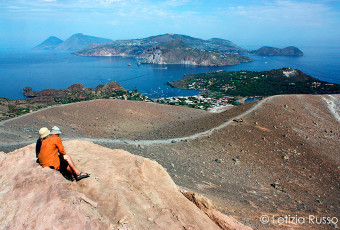Crater’s excursion
The island of Vulcano is named by the Roman god Vulcanus; its activity is in a state of dormancy, but it is possible to observe some phenomena as fumaroles, thermal springs, and muds which prove its state of activity. In the Roman mythology the Vulcano island is considered a place where the forges of Hephaestus, the god of Fire were situated. For those who are not able to give up a naturalistic excursion, the visit to the Great Crater is a MUST. The path leading to the peak is situated at about 5 minutes on foot from Levante mooring, the main port of the island. The excursion is not demanding; it does not require particular equipment or preparation; and is suitable for anybody.
Some advices:
- In summer avoid to climb during the hottest hours because the temperatures can reach 40°. The path, even being easy, has no shades. Bring a little supply of water with you.
- It is recommended to put on comfortable shoes with socks; the sandy ground can provoke bother.
- The access to the volcanoes, making part of the commune of Lipari, is linked to the payment of a small tax. Concerning Vulcano the tax can be directly paid at the beginning of the path; close to the ticket office there is a small kiosk, useful for the absent-minded who forgot to bring any drink supplies with them.
The path towards the peak is a pleasant walk of 45 minutes among brooms, volcanic boulders, and black and sandy soil, mostly compound of volcanic dust. One of the principal reasons to reach the Great Crater is surely the landscape. As you climb you can admire Alicudi, Filicudi, and Salina, but it is only when you arrive to the top that you obtain full awareness of the magic of this archipelago. It will be possible to distinguish the shapes of all the seven islands, and of the Vulcanello Peninsula. The Great Crater of Vulcano is the unique place where it is possible to admire the whole archipelago in a single glance. Looking towards the south, instead , it is possible to admire the northern coast of Sicily ,and Etna; the most evocative images of the archipelago come from this place.
Once reached the peak, we move to discover the crater, the depression of vast dimensions of a diameter of about 500 metres. One of the details that catch your eyes are the fumaroles, unique visible manifestations after the last eruption, occurred in 1890. Fumaroles are generally composed of sulphur, whose bacteria action gives an ochre yellow and red patina to the ground, and to the stones which compound it. While drawing near to it, be careful: if you choose a guided visit you have to wear a mask, given as a supply; in the contrary case, bring a handkerchief with you, in order to put it on your nose and mouth in proximity of sulphuric gas.
The descent is to be done on the same track








